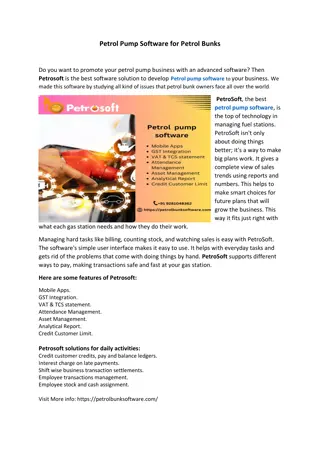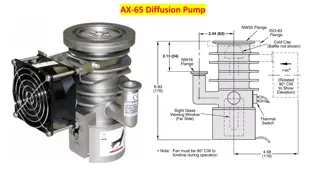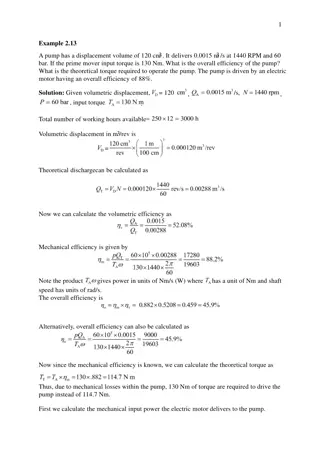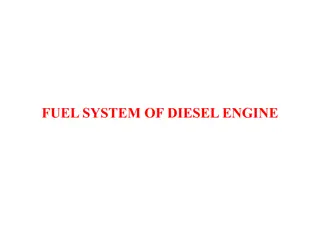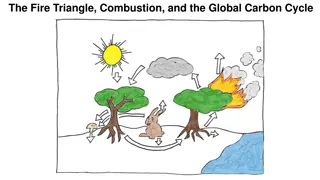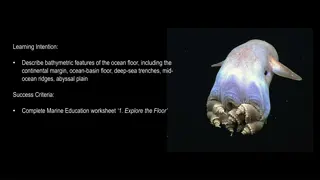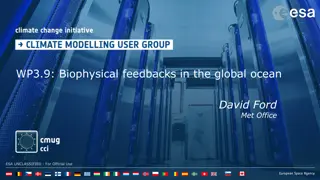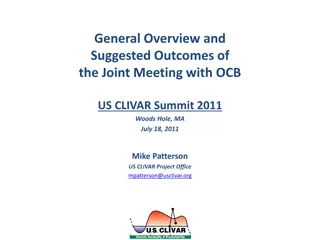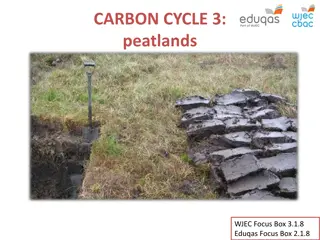Understanding the Biological Pump and Carbon Cycle in the Ocean
The biological pump in the ocean involves photosynthesis by phytoplankton, which removes carbon dioxide from the atmosphere, and respiration, where some CO2 is released back. Phytoplankton are crucial in the ocean's carbon cycle, with primary consumers like zooplankton depending on them for energy. This intricate process maintains a balance of carbon in the ocean and atmosphere, showcasing the vital role of marine organisms in global carbon fixation and circulation.
Download Presentation

Please find below an Image/Link to download the presentation.
The content on the website is provided AS IS for your information and personal use only. It may not be sold, licensed, or shared on other websites without obtaining consent from the author. Download presentation by click this link. If you encounter any issues during the download, it is possible that the publisher has removed the file from their server.
E N D
Presentation Transcript
Photosynthesis and Respiration Photosynthesis Respiration
Photosyntheis and Respiration and atmospheric CO2 Where do we see photosynthesis and respiration on this curve?
The ocean is a large carbon reservoir Only the surface ocean is in equilibrium with the atmosphere What maintains the deep ocean carbon reservoir?
Photosynthesis and Respiration in the Ocean Organisms that perform photosynthesis in the water column of the ocean are called phytoplankton Although phytoplankton account for only 1-2% of the total global biomass, these organisms are responsible for about 30- 60% of the global annual fixation of carbon.
Photosynthesis Carbon dioxide is removed from the atmosphere by phytoplankton that use CO2, sunlight and nutrients to make food through the process of photosynthesis.
CO2 Photosynthesis Phytoplankton
Respiration Some CO2 is then released back into the water through respiration as the phytoplankton break down their food to release energy.
CO2 Photosynthesis Respiration Phytoplankton
Consumption Some of the carbon is passed on to primary consumers: zooplankton (drifting animals living in the water column) and other filter feeders (animals that filter water to catch their food) that depend on phytoplankton for their energy. Animals release CO2 through respiration
CO2 CO2 Photosynthesis Respiration Respiration Phytoplankton Zooplankton Consumption
Decomposition Decomposition is the breakdown of non-living organic matter Bacteria play a vital role in the biological pump by decomposing waste products and dead organisms that sink to the deep sea In most of the ocean, decomposition is aerobic (with oxygen), and essentially the same as respiration (releases CO2). In the upper oceans, bacteria can actually weaken the biological pump by reducing particulate flow to the deep.
CO2 CO2 Photosynthesis Respiration Respiration Phytoplankton Zooplankton Consumption Decomposition Bacteria Remineralization CO2
Higher Trophic Levels Consumption continues to transport carbon through higher trophic levels. These higher level consumers are eventually decomposed
CO2 CO2 CO2 Photosynthesis Respiration Respiration Phytoplankton Respiration Zooplankton Consumption Decomposition Higher Level Consumers Consumption Consumption Decomposition Bacteria Remineralization CO2
Deep Ocean Carbon Storage The deep ocean is not in equilibrium with the atmosphere and therefore stores any CO2 released into the deep ocean for ~1000 years.
Overview of the Biological Pump Courtesy of Z. Johnson and Nature Magazine, October 12, 2001.
What limits phytoplankton growth? If there is plenty of carbon in the upper ocean (there is) and plenty of light why isn t there more biomass?
Nutrient Limitation Like all primary producers, phytoplankton need essential nutrients (N, P, C, and trace metals like Fe, Co, Mg) to grow The upper ocean has very low nutrients Nutrient Limitation the concept that growth is limited by nutrient availibility Dutkiewicz et al 2012
N, P, Fe How do N, P, and Fe enter the ocean? N Nitrogen Fixation (The chemical processes by which atmospheric nitrogen N2 is assimilated into bioavailable compounds) Only a few organisms Fe dust from continents P, N, Fe upwelling from the deep



